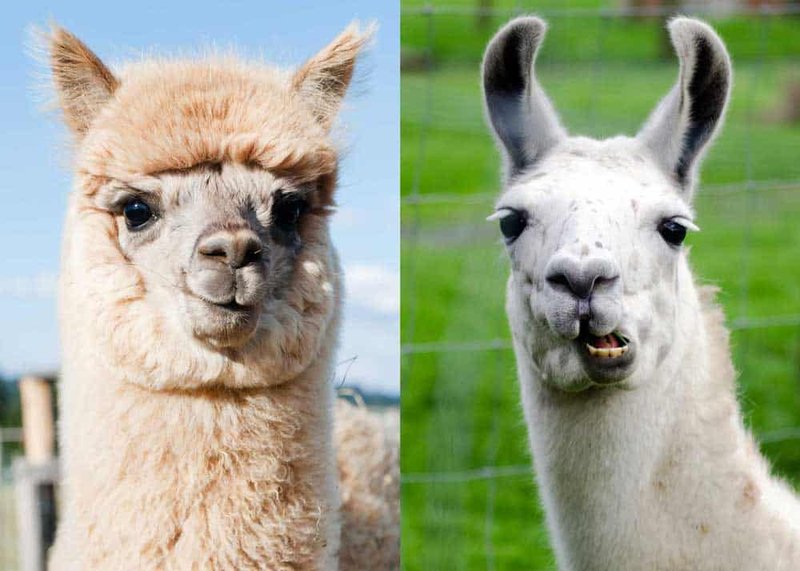
At first glance, llamas and alpacas may seem similar, but once you dive into their traits, personalities, and uses, you’ll see how unique each creature is. If you’re considering adopting one as a pet, using them for farming, or just want to impress your friends with some fun facts, this guide will take you through the key differences in size, temperament, and use. So grab a cup of coffee, and let’s chat about these fascinating animals!
Size: How Llamas and Alpacas Stack Up
When it comes to size, llamas are the towering giants of the camelid world, while alpacas are more like the petite companions. Generally, a fully grown llama can stand anywhere between 4.5 to 6 feet tall at the top of their heads, with an average weight of around 250 to 450 pounds. In contrast, alpacas are typically 3 to 4 feet tall and weigh between 100 to 200 pounds.
You might be wondering why size matters. Well, if you’re thinking of keeping one as a pet, their size could influence your choice. For instance, llamas are better suited to larger spaces and can act as guardians for other livestock, while alpacas thrive in smaller enclosures and are often favored for their friendly demeanor.
So, when comparing llamas and alpacas, remember this: If you want a larger, more imposing animal, you’re looking at llamas. But if a smaller, more affectionate buddy sounds appealing, alpacas are your go-to.
Temperament: Which One Fits Your Lifestyle?
A llama’s temperament can be quite different from that of an alpaca, and it’s essential to consider what you’re looking for. Llamas are known for their independence and can sometimes be a bit more standoffish. They can also be protective, which makes them excellent guardians for herds but might also mean they’ll challenge you if they feel their space is threatened.
On the other hand, alpacas are often described as gentle and social. They tend to be more curious and can form strong bonds with their human caretakers. Think of them as the friendly neighbor who always waves and brings you cookies! If you’re looking for a companion that enjoys interaction and isn’t afraid to cuddle, an alpaca might be the perfect match.
However, llamas can also be friendly and affectionate when raised properly. Their personalities can vary, so it’s wise to spend time with both before making a decision.
Uses of Llamas and Alpacas: The Practical Side
The uses of llamas and alpacas also differ, reflecting their unique characteristics. Llamas have historically been used as pack animals due to their strength and endurance. They’re capable of carrying loads of up to 25% of their body weight over long distances, making them excellent companions for hikers or farmers transporting goods.
On the flip side, alpacas are primarily valued for their fiber. Their fleece is incredibly soft and hypoallergenic, often compared to cashmere. You might find sweaters, scarves, and blankets made from alpaca wool at your local craft fair.
So, if you’re considering which animal to keep, think about what you need. Need a sturdy helper for outdoor work? Go with a llama. Want to produce beautiful, warm clothing? An alpaca is your best bet.
Physical Differences: A Closer Look
Besides size, there are some notable physical differences between llamas and alpacas that can help you spot them in a crowd. One major distinction lies in their faces. Llamas have a longer, more elongated snout, while alpacas sport a shorter, more compact face. This might sound like a minor detail, but it can make identifying them a lot easier.
Additionally, the ears of these two creatures vary significantly. Llamas typically have long, banana-shaped ears, whereas alpacas have smaller, spear-shaped ears that stand upright. These physical traits not only affect their appearance but also contribute to their different temperaments and behaviors.
So next time you come across these charming animals, take a moment to appreciate their unique features. It’s like seeing the difference between a Great Dane and a Chihuahua—both are fabulous in their own right!
Care Requirements: What to Expect
If you’re thinking about adding a llama or alpaca to your family, it’s important to consider their care needs. Both animals require similar basic necessities: a balanced diet, proper shelter, and regular veterinary attention.
Llamas tend to eat more due to their size. They usually need about 2 to 4 pounds of hay per day. Alpacas, on the other hand, can thrive on slightly less, around 1.5 to 2 pounds of hay. Both animals also enjoy fresh grass and some grains, but it’s essential to avoid overfeeding them, as this can lead to health issues.
When it comes to housing, both species need protection from extreme weather conditions. Adequate shelter, whether in the form of a barn or a simple windbreak, is crucial. Regular grooming is also necessary—alpacas need it more often due to their dense fleece, while llamas tend to have coarser hair that requires less maintenance.
In summary, while both animals have similar care requirements, it’s vital to account for their individual needs based on size and temperament.
Social Behavior: Llamas vs. Alpacas
Understanding the social behavior of llamas and alpacas can help you decide which is best for you. Both animals are naturally herd animals, which means they thrive in a group setting. Keeping just one can lead to loneliness and stress, so it’s best to have at least two.
Llamas tend to be more dominant in social settings. They’ll often establish a hierarchy, which is fascinating to observe. Their protective nature can make them a little more aloof, but they will bond closely with their fellow llamas and human caretakers.
Alpacas, in contrast, are more likely to socialize with all members of their herd equally. They often engage in playful behaviors, such as chasing each other or playing “king of the hill” on a small mound. Their gentle nature makes them less likely to establish hierarchy, creating a more harmonious environment.
So, whether you want a more independent companion or a playful friend, knowing their social behavior can help you make the right choice.
In summary, when deciding between a llama and an alpaca, it really comes down to what suits your lifestyle and needs. Llamas are larger, more independent, and often better for tasks like guarding livestock or carrying loads. Alpacas, on the other hand, are smaller, incredibly sociable, and prized for their luxurious fiber.
Reflect on what you’re hoping to gain from having one of these amazing animals in your life. Whether you want a loving companion or a hardworking helper, both llamas and alpacas have their unique charm. Remember, each animal has its personality, and spending time with them will help you make the best choice.
Ultimately, no matter which one you choose, you’re in for a delightful experience with these fluffy friends!

